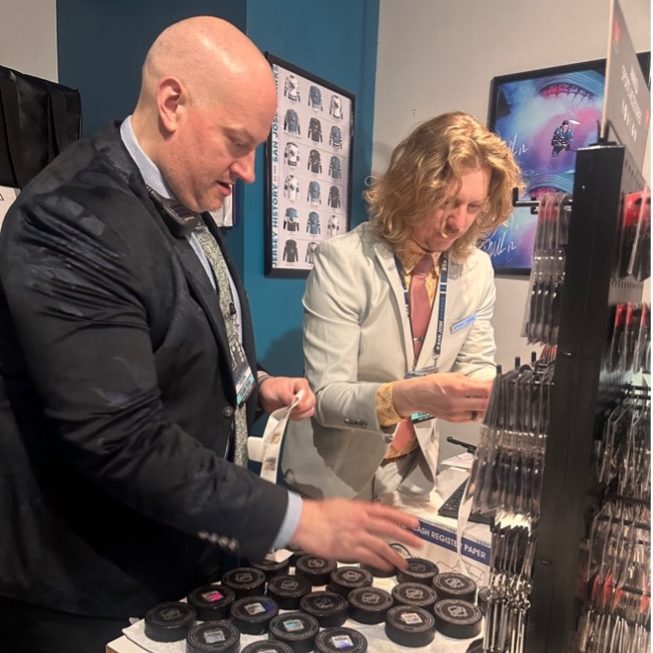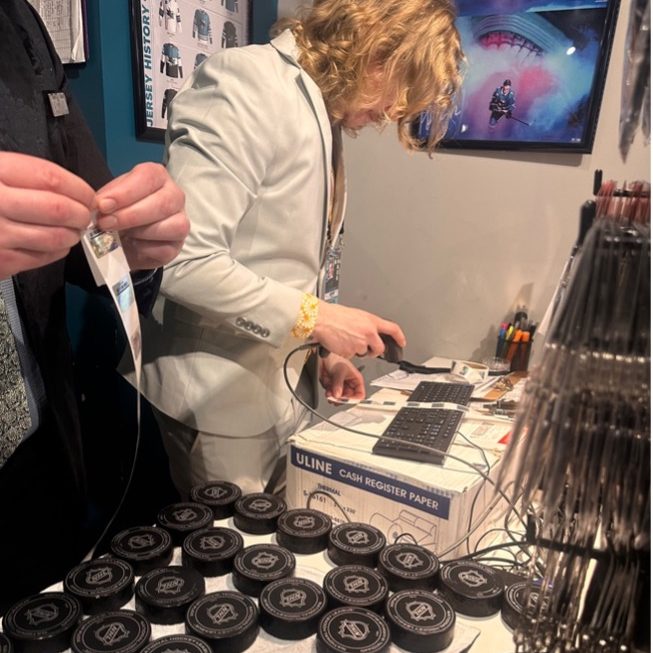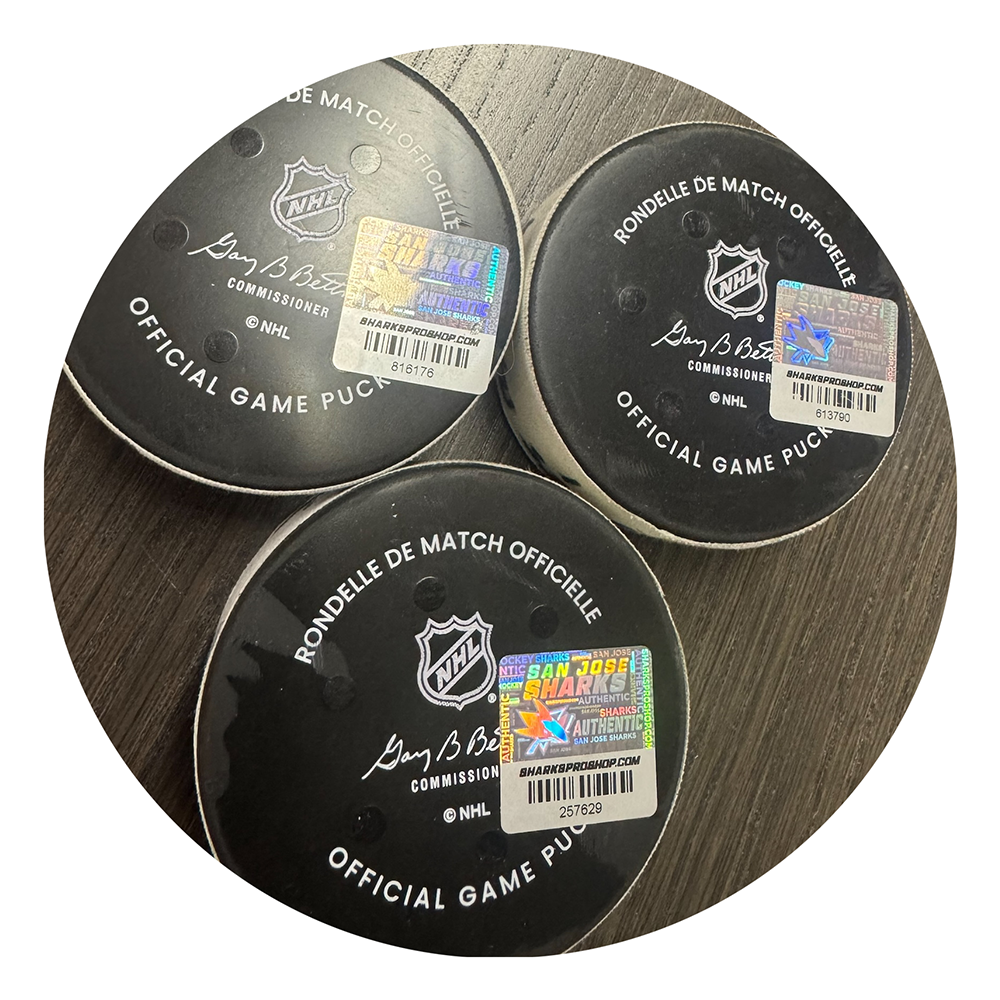Key Points
1. Hologram authentication increases memorabilia value
2. Tamper-evident stickers create a verifiable chain of custody from ice to consumer
3. Authentication process streamlined to deliver game-used items within 15 minutes


Pete Pensa (Left) and Justin Tang (Right) apply NovaVision holograms to San Jose Sharks game-used pucks / Aramark Sports + Entertainment
In the thriving world of sports memorabilia, authenticity is everything. When fans purchase a game-used hockey stick or a puck that scored a winning goal, they’re not just buying an object—they’re investing in a tangible piece of sports history. But as the market grows, so does the challenge of ensuring these items are genuine.
This case study examines how Aramark Sports + Entertainment, the retail partner of the San Jose Sharks NHL team, implemented NovaVision’s hologram authentication technology to protect the integrity of their game-used memorabilia program. Through interviews with Aramark’s team and industry research, we’ll explore how this solution has enhanced consumer confidence, streamlined operations, and increased the value of authenticated memorabilia.
The Growing Sports Memorabilia Market
The global sports memorabilia market is experiencing remarkable growth. According to Econ Market Research, the market was valued at USD 16.52 million in 2023 and is projected to reach USD 52.62 million by 2032, growing at a compound annual growth rate (CAGR) of 13.74%. Other sources suggest even larger figures, with Splint Invest reporting the 2023 global market value at 35.69 billion USD, expected to grow to 103.02 billion by 2032.
This expansion is driven by several factors. The emotional connection fans have with their favorite teams and athletes creates a powerful desire to own items associated with memorable sporting moments. As Pete Pensa of Aramark explains: “It’s something tangible… it’s a memory you’re locking of ‘I caught that puck on this date at this time.'”
The investment potential of sports memorabilia has also contributed to market growth. According to a study by the Wharton School of Business, autographs have shown impressive appreciation over the last 50 years, with even simple autographs demonstrating an average annual increase of more than 9%. High-profile sales highlight this potential—a pair of Michael Jordan’s sneakers from his ‘flu game’ sold for $104,765 in 2013, only to fetch $1.38 million when auctioned again in 2023.
However, this growth has created a significant challenge: counterfeiting. As the Econ Market Research report notes, “The market’s integrity is compromised by the abundance of fake goods, which erodes collectors’ confidence. Potential purchasers are discouraged, and market trust is impacted by the possibility of inadvertently purchasing phony artifacts.”
The Authentication Challenge
For organizations like Aramark that manage retail operations for professional sports teams, ensuring the authenticity of memorabilia is crucial to maintaining consumer trust and protecting brand reputation.
Pete Pensa describes the problem they faced: “There were a few times in the past where there were items that we knew were not game-used items, but they were on secondary markets being sold as game-used items. We don’t have any contact with the seller, nor do we know who actually purchased those items. But we know that there’s someone out there that received that item, and the information they were given was misinformation.”
This scenario is all too common in the sports memorabilia market. Without proper authentication, fans may unknowingly purchase counterfeit items, damaging their trust in the market and potentially devaluing authentic pieces. As Pensa notes, “We wanted to make sure that fans had the best experience possible, and that they were getting real merchandise.”
Prior to implementing their current solution, Aramark used a basic certificate of authenticity, but it “didn’t quite hit the level of security” they needed. As Pensa explains, “It didn’t bring the same weight that the non-tampering holographic sticker really brought to the market.”
The NovaVision Solution
After evaluating several options, Aramark selected NovaVision’s hologram authentication technology. NovaVision specializes in creating tamper-evident hologram labels that provide an additional layer of security to products.
These hologram stickers feature unique designs and advanced holography techniques that make them extremely difficult to duplicate. As NovaVision explains, “When viewed from different angles, hologram labels refract light, appearing to shift and change in color and even design or features. These labels may also include additional security features like microprinting, covert laser reveal, fluorescing inks, floating images, and more.”
For Aramark, several specific features influenced their decision:
- Serial numbering: Each hologram contains a unique serial number that can be tracked in a database.
- Barcode functionality: The holograms include scannable barcodes for quick verification.
- Micro-text: NovaVision embeds microscopic text hidden within the hologram design as another authentication feature.
- Tamper-evident properties: If someone attempts to remove the hologram, it shows clear evidence of tampering, including leaving adhesive residue on the surface.
- Custom design: The holograms can be customized with team logos and specific security features.
As Justin Tang of Aramark explains, “Between the sizing, the serial numbering, the barcode, and the design, they really hit on all of the marks. You could always find someone that could offer a sticker, but they couldn’t serial number it, or they could serial number it, but they couldn’t put a barcode on it.”
Implementation Process
The implementation of NovaVision’s hologram authentication system at the Sharks Pro Shop was remarkably smooth. According to Pensa, “It was pretty seamless and straightforward. NovaVision made things a lot easier and streamlined our process for maintaining the database on our end.”
The authentication process follows these steps:
- Collection: Game-used equipment is collected from the San Jose Sharks locker room.
- Documentation: The locker room staff keeps detailed records of when items were used, by which players, and in which games.
- Transfer: Aramark staff retrieves the items along with their documentation.
- Authentication: Hologram stickers are applied to each item.
- Database Entry: Each item’s details and corresponding hologram serial number are entered into a database.
- Verification System: The database is accessible through the Sharks Pro Shop website, allowing customers to verify their purchases.
This process creates what Pensa calls a “chain of custody” from the ice to the consumer: “The item went from locker room, to authenticity, to the Sharks Pro Shop team. You can follow the train all along the way.”
The efficiency of this system is particularly evident on game days, when Aramark authenticates approximately 40 pucks that come off the ice. Pensa describes the rapid process: “We have to basically pull [them] off the ice, they’re still stone cold, apply the stickers, scan them, and get them up to the fans before the national anthem ends. With the setup that NovaVision provides us, we’re able to go from warm-ups to on sale in about 10-15 minutes.”
The Sharks “Authentics” Program
The authenticated memorabilia is sold through the Sharks Authentics program, which offers “official game-used, team-issued, and team stock memorabilia from the San Jose Sharks.” According to the Sharks Pro Shop website, “Each item comes directly from the locker room or the ice, giving fans the unique opportunity to own a notable piece of Sharks history.”
The program distinguishes between different types of memorabilia:
- Game-used memorabilia: Equipment worn or used by a player during an official NHL game, with details about which player used the item and in which specific games.
- Team-issued memorabilia: Equipment or apparel issued to a player but not necessarily used during an official game, such as practice gear or training equipment.
- Team stock items: Equipment or apparel manufactured for a player or team but never actually used in a game or practice.
Each item in the Sharks Authentics program “is equipped with a unique code that ties directly to your collectible for verification. To verify your item’s authenticity, simply find the code on your product and enter the code to confirm that it has been officially authenticated by the San Jose Sharks.”
This verification system is crucial for maintaining trust in the secondary market. As Pensa explains, “The database will be there forever. If the item gets sold or resold, the data will still be around. Whoever owns the item will be able to go on and verify all the details of where it was used, which athlete used it, the dates, and any other pertinent details.”
Business Impact and Benefits
The implementation of NovaVision’s hologram authentication system has delivered significant benefits for Aramark and the San Jose Sharks:
1. Increased Value
Perhaps the most tangible benefit has been the increase in the value of authenticated memorabilia. According to Pensa, “With that extra value of trust and the lack of skepticism, we have increased the value in the theoretical resale value of each one of these items, whether it’s a puck or a broken stick.”
This aligns with industry research showing that authenticated items typically command higher prices in both primary and secondary markets. As Sports Cards Investing notes, “One of the most popular ways to increase the value of your autographed sports cards is to have them authenticated and encapsulated. This not only helps ensure that the autograph is real, but it also protects the card against future wear and tear.”
2. Enhanced Consumer Trust
The hologram authentication system has significantly improved consumer confidence in the Sharks Authentics program. As Pensa explains, “There’s a level of trust built into this now, where you know that it’s coming from the locker room because we are adding that extra layer of protection.”
This trust is particularly important given the prevalence of counterfeit memorabilia in the market. As Packaging Digest reports, “With licensed sports merchandise continuing to grow as a major revenue source for trademark owners, it has become an all-too-tempting target for counterfeiters. As unscrupulous vendors grow bolder and more sophisticated in their methods, security countermeasures must also keep pace in the ongoing war to protect intellectual property.”
3. Operational Efficiency
The NovaVision system has streamlined Aramark’s authentication process, particularly for time-sensitive items like game-used pucks. The barcode functionality allows for quick scanning and processing, which is essential when handling large volumes of memorabilia.
As Pensa notes, “The team required us to have a certain level of ease of use for their staff because they’re dealing with thousands of pieces of equipment, and they can’t sit down and write each number down, so they need to scan and quickly process some of these pieces.”
4. Market Differentiation
By implementing a robust authentication system, the Sharks Authentics program has differentiated itself in the competitive memorabilia market. The hologram stickers serve as a visible symbol of authenticity that distinguishes official merchandise from unauthorized items.
This differentiation is particularly important for attracting serious collectors who value provenance and authenticity. As Hall of Fame Grading notes, “When it comes to sports memorabilia, having an authenticated autograph can make all the difference. For collectors and fans alike, owning a piece of history signed by their favorite athlete is not only a tangible connection to the game but also a valuable investment.”
The Psychology of Collecting
Understanding why fans collect sports memorabilia provides important context for the value of authentication. The research reveals several psychological factors that drive collecting behavior:
Emotional Connection
At the core of collecting is an emotional connection to the sport, team, or athlete. As Awesome Artifact explains, “Sports have a unique ability to evoke powerful emotions, whether it’s the thrill of victory or the agony of defeat. The memories attached to significant games, legendary players, and pivotal moments in sports history create a rich tapestry of feelings that fans cherish.”
Pensa observes this in Sharks fans: “Most people that are buying memorabilia are buying it to keep, not resell. The end user is going to just hold it and pass it down to family or have a story.”
Identity and Belonging
For many collectors, sports memorabilia reinforces their identity as a fan. According to Awesome Artifact, “Owning autographed memorabilia can reinforce one’s allegiance to a particular team or player, and fosters a sense of belonging within a community of fellow fans.”
Yellowbrick adds that “sports have a unique ability to evoke strong emotions, and fans often develop a deep attachment to their chosen team. This emotional connection creates a sense of belonging and identity, making fans more likely to support their team through thick and thin.”
Nostalgia
Nostalgia plays a significant role in collecting behavior. Awesome Artifact notes that “many items are emblematic of different eras, reminding fans of their own experiences and the cultural context surrounding a particular sport at that time.”
Pensa describes how this works with game-used items: “When you go to a baseball game, and there’s a home run or a foul ball, people run for it… It’s not worth anything, but it’s something… it’s a memory.”
The Thrill of the Chase
Many collectors enjoy the pursuit of rare or significant items. American Legends explains, “Collectors enjoy searching for and acquiring cards that complete their collections. The chase can be just as satisfying as the actual acquisition of the card.”
Pensa observes this behavior among Sharks fans: “I think a lot of people get going on the thrill of the chase… For us this year, having Macklin Celebrini as our big rookie, having him come in, and then everybody chasing his first this, his first that… Or it’s just favorite players. If you have a superstar on a team, that’s their favorite player. So everybody’s trying to chase a goal from this night, a stick from this night.”
The Future of Authentication in Sports Memorabilia
The sports memorabilia market continues to evolve, with new technologies and approaches to authentication emerging. While hologram stickers represent the current standard for physical authentication, several trends are shaping the future of the industry:
Digital Authentication
Digital technologies are increasingly being integrated with physical authentication methods. Blockchain-based solutions, in particular, offer new possibilities for verifying the provenance of collectibles.
As Protokol explains, “Blockchain digital collectibles are changing the game off the playing field, providing fans with individually-unique or provably-scarce digital memorabilia that’s secure, interoperable, easily transferable and verifiable… A blockchain can track digital collectibles’ lifecycles and entire ownership history forever, meaning fans benefit from more complete ownership of their assets.”
NFTs and Physical-Digital Hybrids
Non-fungible tokens (NFTs) represent a growing segment of the sports collectibles market. As OneMint notes, “NFTs provide verifiable ownership, ensuring collectors that they are the true owners of their digital assets. This eliminates the risk of tampering and fraud, while also making it easier to transfer ownership or trade cards with others.”
Some companies are exploring hybrid approaches that combine physical memorabilia with digital authentication or companion NFTs, offering the tangible experience collectors value with the security and transferability of digital assets.
Enhanced Physical Security Features
Physical authentication methods continue to advance, with increasingly sophisticated security features being incorporated into hologram stickers and other authentication markers. These may include:
- Taggants are invisible to the human eye, but can be viewed with an infrared light
- Covert laser reveal shows an image through a reflection of a laser
- Microprinting and hidden images visible only under specific conditions
- Color-shifting inks that change appearance when viewed from different angles
- Forensic markers detectable only with specialized equipment
- Unique material properties that cannot be replicated
Industry-Wide Standards
As the market matures, there is growing interest in developing industry-wide standards for authentication. This could include standardized protocols for documenting provenance, consistent verification systems across teams and leagues, and shared databases of authenticated items.
Pensa notes that Aramark’s successful implementation of the NovaVision system has already attracted interest from other teams: “Our counterparts were a springboard for us to try this process. We asked them how they handled their process, and then we took their blueprint and applied our own vendors to it. They are now coming back to us because of the success. Next season or during the off-season, other teams will look into to implementing the NovaVision holograms.”
Conclusion: The Value of Trust in Collectibles
Aramark’s and San Jose Sharks’ case demonstrates how hologram authentication technology can address the challenges of counterfeiting in the sports memorabilia market. By implementing NovaVision’s solution, they have created a robust system that ensures the authenticity of game-used items, enhances consumer confidence, and increases the value of their memorabilia.
As Pensa summarizes, “It used to come from a certificate and trust. And now there are too many counterfeits. Fans want an extra layer of security.”
The success of this implementation highlights several key lessons for organizations in the collectibles market:
- Authentication creates value: The 10-25% increase in value demonstrates the tangible return on investment from implementing robust authentication systems.
- Efficiency matters: The ability to quickly authenticate items, particularly in time-sensitive situations like game days, is crucial for operational success.
- Consumer trust is paramount: In a market where emotional connection drives purchasing decisions, maintaining trust is essential for long-term success.
- Documentation enhances value: Detailed records of an item’s provenance, accessible through a verification system, add to both the monetary and emotional value of collectibles.
- Technology must serve the fan experience: Ultimately, authentication systems should enhance the connection between fans and the sports moments they cherish.
As the sports memorabilia market continues to grow, authentication will remain a critical component of the ecosystem. Whether through hologram stickers, blockchain records, or hybrid physical-digital solutions, the ability to verify the authenticity of collectibles will continue to be essential for maintaining trust, protecting value, and preserving the emotional connection that drives the market.
For Aramark and the San Jose Sharks, the NovaVision hologram authentication system has proven to be more than just a security measure—it’s an enhancement to the fan experience and a valuable business tool that protects both their brand and their customers’ investments in pieces of hockey history.
Selecting the right security label matters—NovaVision’s specialists will help identify the best solution to protect your cannabis products and brand.
Talk to an Expert
